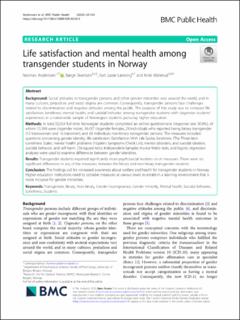Life satisfaction and mental health among transgender students in Norway
Journal article, Peer reviewed
Published version

Åpne
Permanent lenke
https://hdl.handle.net/11250/2726987Utgivelsesdato
2020-01Metadata
Vis full innførselSamlinger
Originalversjon
10.1186/s12889-020-8228-5Sammendrag
Background
Social attitudes to transgender persons and other gender minorities vary around the world, and in many cultures, prejudices and social stigma are common. Consequently, transgender persons face challenges related to discrimination and negative attitudes among the public. The purpose of this study was to compare life satisfaction, loneliness, mental health, and suicidal behavior among transgender students with cisgender students’ experiences in a nationwide sample of Norwegian students pursuing higher education.
Methods
In total,50,054 full-time Norwegian students completed an online questionnaire (response rate 30.8%), of whom 15,399 were cisgender males, 34,437 cisgender females, 28 individuals who reported being binary transgender (12 transwomen and 16 transmen), and 69 individuals non-binary transgender persons. The measures included questions concerning gender identity, life satisfaction (Satisfaction With Life Scale), loneliness (The Three-Item Loneliness Scale), mental health problems (Hopkins Symptoms Check List), mental disorders, and suicidal ideation, suicidal behavior, and self-harm. Chi-square tests, Independent-Samples Kruskal-Wallis tests, and logistic regression analyses were used to examine differences between gender identities.
Results
Transgender students reported significantly more psychosocial burdens on all measures. There were no significant differences in any of the measures between the binary and non-binary transgender students.
Conclusion
The findings call for increased awareness about welfare and health for transgender students in Norway. Higher education institutions need to consider measures at various levels to establish a learning environment that is more inclusive for gender minorities.
